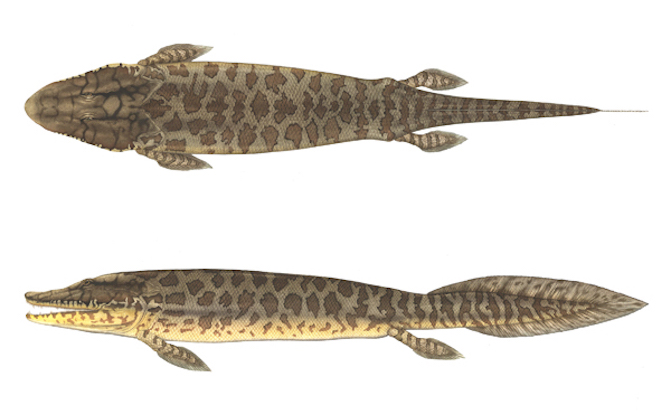
Why Don't Fish Have Necks?

Fish have fins and gills, but they don't have necks. That's partly because it would be difficult to swim quickly with a neck that wagged back and forth in the water.
What's more, anything called a fish, by definition, can't have a neck. The moment a fish-like creature developed a neck, it became classified as another type of animal, experts told Live Science.
The oldest neck on record belongs to Tiktaalik roseae, a creature that lived about 375 million years ago, during the Devonian period. Scientists describe T. roseae as part fish, part tetrapod (a four-limbed animal), said Ted Daeschler, the curator of paleontology at the Academy of Natural Sciences of Drexel University in Philadelphia. [See Images of the Weird Ancient Fish-Like Fossil, Titktaalik]
Instead of necks, fish have a series of bones that connect the skull to the shoulder girdle, which attaches to the fins, Daeschler said.
"The shoulder girdles are those bony elements, like the clavicle and the scapula, that support the front appendage, whether it's a fin or a limb," Daeschler told Live Science. "[In fish] they're connected not always terribly tightly, but it's one solid surface of bone."
Over time, some fish began to change shape. Take, for instance, the lobe-finned fish, which includes the coelacanth — an ancient group thought to be extinct until fishermen rediscovered them off the South African coast in 1938. According to the fossil record, the lobe-finned fishes, over time, lost some of the bones that connected the shoulders to the skull.
Researchers consider the 9-foot-long (2.7 meters) T. roseae a lobe-finned fish, Daeschler said. But it completely lost the bones that connected the skull to the shoulder girdles, and instead developed a neck. This neck likely helped it hunt in shallow, freshwater environments, he said. [Photos: The Freakiest-Looking Fish]
Sign up for the Live Science daily newsletter now
Get the world’s most fascinating discoveries delivered straight to your inbox.

"[Its neck] allowed the head to move independently from the body," Daeschler said. "That's great if you live in in shallow, swampy areas, where you might need to turn your head quickly to grab prey or to reach up to breathe."
In contrast, without a neck, fish have to move their entire bodies to aim their head in a certain direction.
One fish, two fish
Was Tiktaalik strictly a fish or a tetrapod? "It's in the gray area, which is what's so cool about evolution," Daeschler said.
This gray area lasted about 20 million years as that lineage evolved from lobe-finned fishes to four-limbed amphibians, he said. Scientists call this gray area — when some parts of an animal evolve, but other parts remain in their primitive forms — "mosaic evolution."
Animals with necks had a unique advantage; they could quickly steer their mouth without having to move their entire bodies. In fact, "all of these early tetrapods were predators, no doubt about it," Daeschler said.
But many fish are predators, too, and they have been very successful without necks, he said. Moreover, whales and dolphins are thought to have once lived on land before they moved back into the water. Once they became marine animals again, whales and dolphins greatly shortened their neck vertebrae, so that the entire neck is short and rigid instead of being long and flexible.
"The idea there was that long and flexible necks are not great if you're jetting though the water," Daeschler said. "Your head gets thrown to the side by the pressure. It's better not to have a neck and just be a torpedo and swim forward."
Follow Laura Geggel on Twitter @LauraGeggel. Follow Live Science @livescience, Facebook & Google+. Original article on Live Science.

Laura is the archaeology and Life's Little Mysteries editor at Live Science. She also reports on general science, including paleontology. Her work has appeared in The New York Times, Scholastic, Popular Science and Spectrum, a site on autism research. She has won multiple awards from the Society of Professional Journalists and the Washington Newspaper Publishers Association for her reporting at a weekly newspaper near Seattle. Laura holds a bachelor's degree in English literature and psychology from Washington University in St. Louis and a master's degree in science writing from NYU.










